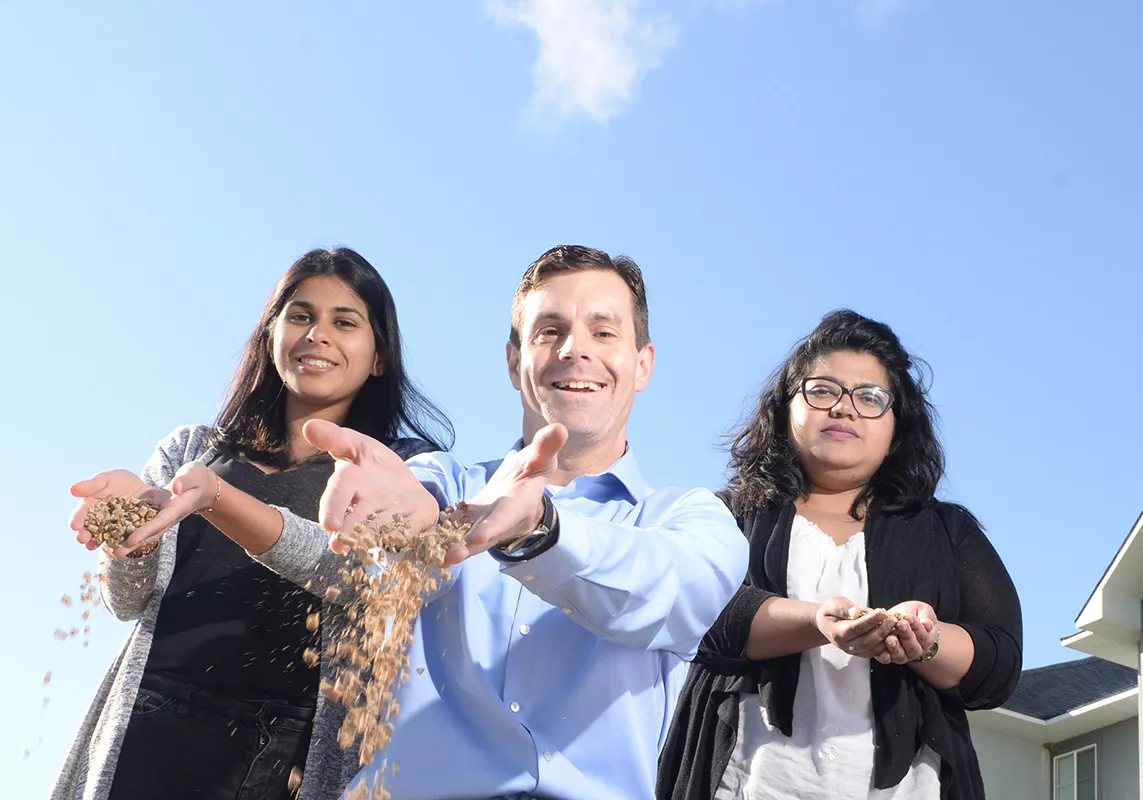Demonstrating the Potential of Renewable Energy
By using wood pellets as the primary heating fuel for four campus buildings, UNBC is reducing its carbon output, saving money and demonstrating how other institutions and communities can reduce their fossil fuel consumption. The project has been made possible through the contributions of government and industry as part of the Northern Leadership Campaign.

The worldwide transition to a low-carbon economy requires innovative local solutions to pressing global challenges. In the North, one such challenge is to find ways to heat buildings efficiently, sustainably and cost-effectively.
At the University of Northern British Columbia, the Sustainable Communities Demonstration Project (SCDP) is doing just that. By using wood pellets as the primary heating fuel for four campus buildings, the University is reducing its carbon output, saving money and demonstrating how other institutions and communities can reduce their fossil fuel consumption.
“This project is a big experiment to see how much it costs to convert the heat and hot water sources from natural gas and electricity to wood, to examine how efficient a district system can be and find out any other benefits to making the change,” says UNBC Assistant Director, Facilities Dr. David Claus.
The first phase of the SCDP capital project wrapped up in September 2017 with the Keyoh residence at the UNBC Childcare Centre joining the low-temperature district energy system. The Neyoh residence and the IK Barber Enhanced Forestry Laboratory (EFL) were connected in 2016.
“The UNBC bioenergy systems do more than simply heat the buildings at our Prince George campus, they are a research facility, a teaching tool and demonstration model for rural and remote communities,” says UNBC President Dr. Daniel Weeks. “By inviting representatives to see our Bioenergy Plant and wood pellet boiler, we can educate communities to help them find innovative solutions to their energy needs.”
Through the Northern Leadership Campaign, industry and government partners joined UNBC researchers to create a local solution with a global impact through the SCDP. The total cost of the capital project is $2.2 million, with $1.1 million coming from the Province of British Columbia. The Omineca Beetle Action Coalition, TransCanada Corporation and the BC Bioenergy Network have also made funding commitments. Pacific BioEnergy is donating the wood pellets that fuel the system.
Contributions from industry and government give northern communities the chance to make renewable energy and environmental sustainability a foundation for the next generation.
The wood pellet boiler is the primary heat source for the hot water loop, backed up by UNBC’s award-winning Bioenergy Plant. Energy transfer stations in each building extract heat from the water and then use that heat to keep the buildings warm and provide on-demand hot water.
“The system provides a very comfortable, even heat,” Claus says. “The project is a very functional addition to the overall infrastructure and assets that we have at the University.”
The early results demonstrate the system’s efficiency and cost-effectiveness. In the first year, with only one of the two residence buildings and the EFL connected, energy savings topped $95,000. This year with the second residence building and daycare added to the loop, the savings will likely increase.
The reduction in carbon emissions are also substantial. Projections indicate the SCDP will result in a 350-tonne decrease in emissions each year, equivalent to removing 110 cars off the road.
The SCDP is more than saving money and finding an innovative method of heating the two residence buildings, daycare and greenhouse. From the beginning, it has been about research and demonstration.
Six years ago, when the project was still on the drawing board, a group of students conducted a research project to look at how the residence buildings consumed energy. The students’ findings informed the design of the SCDP and with the new system now up and running, their historic data can be compared with how much energy the buildings use now.
Claus, a professional engineer, is also an instructor at UNBC and engages current students in discussions about how the system works.
“One of the classes I taught last year included a number of environmental engineering students who were living in residence,” Claus said. “They were able to tell me what was working and what was not working from their perspective living in the building and allowed us to make improvements to the system.”
The project demonstrates how high-density buildings in close proximity can transition from natural gas and electricity to a hot-water heating system in a cost-effective manner. This is something that can be replicated in the downtown or central core of rural and remote communities across the North and around the world.
The UNBC system heats water to about 80 degrees, a temperature that would make it compatible with renewable heat sources other than wood.
“Once you have converted your building from natural gas and electricity to a low-temperature hot water system, you have the luxury of switching heating sources,” Claus explains. “You just need to make hot water and you can do that in a number of ways.”
The UNBC system uses wood pellets, but other options include geo-exchange systems to pull heat out of the ground, excess heat produced by industrial plants or, in certain climates, air-source heat pumps that pull heat out of the air.
With the first phase complete, the focus of the next SCDP project will shift to discovering more ways to demonstrate community sustainability in the North. Examples could include exploring ways to scale up the production of local food or demonstrating the ultra-energy efficient passive house concept.
“We are looking at the amenities that help people enjoy life living in the North and what we need to achieve that sustainably,” Claus says. “To foster a healthy relationship between Northern residents and the environment, we must explore new ways for buildings to respond both to the environment and to occupants.”